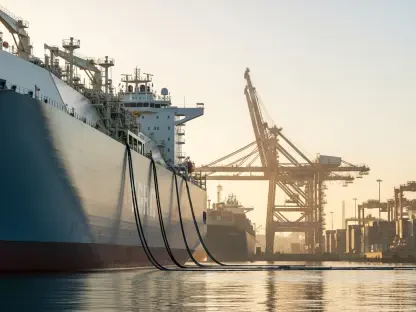Christopher Hailstone, a seasoned expert in energy management, renewable energy, and electricity delivery, has observed the evolving landscape of the utilities sector. His insights into grid reliability and security are invaluable, offering a deeper understanding of how companies like BP navigate the shifting sands of energy economics. Today, we dive into the challenges BP faces, following significant changes in profits and strategy.
Can you elaborate on the factors that contributed to the 48% drop in BP’s net profit?
The 48% drop in BP’s net profit can be attributed to several interlinked factors. Firstly, there were weaker trading results within the gas sector. This period also witnessed decreased refining margins, which directly impacted profitability. External elements like fluctuating global oil prices played a role, alongside internal challenges such as asset sales that reduced production capacity.
What role did weaker gas trading and refining results play in the reduced profitability?
Weaker gas trading and refining results significantly impacted BP’s financial health. Gas trading, often a volatile market, saw decreased returns, which was compounded by reduced refining margins. Refining profitability shrank as industry-wide trends influenced the average margins per barrel, dropping noticeably compared to the previous year’s figures.
How is BP planning to address the challenges and shore up investor confidence following the profit drop?
BP is adopting several strategic measures to tackle these challenges and boost investor confidence. CEO Murray Auchincloss has indicated a plan to streamline operations via asset sales with an estimated value of $20 billion by 2027. This aims to optimize their portfolio while potentially generating cash flow to reinvest and stabilize the company’s financial outlook.
What strategic measures is CEO Murray Auchincloss implementing to cut costs and improve profitability?
CEO Auchincloss is focused on cost-cutting strategies, such as reducing spending, slowing down share buybacks, and executing refinery maintenance programs that align with current industry standards. These steps are designed to balance the company’s budget and enhance profitability through a more disciplined financial approach.
Can you discuss the implications of BP’s plan to sell $20 billion in assets through 2027?
Selling $20 billion in assets over the next few years is a profound move for BP. This strategy implies a pivot toward refining its business model and concentrating efforts on more profitable sectors. By offloading non-core assets, BP aims to reduce debt and free up additional capital to invest in higher-yield projects, thus potentially mitigating the impact of market uncertainties.
How will the departure of strategy and sustainability chief Giulia Chierchia impact BP’s future strategy?
Giulia Chierchia’s departure signifies a shift in BP’s strategic focus. With her exit, BP is stepping back from an aggressive expansion into low-carbon ventures. This transition may alter how BP positions itself in the market, potentially focusing more on traditional energy sources while reassessing its long-term sustainability initiatives.
Why did BP decide to abandon the previous strategy of slashing hydrocarbon production and boosting its low-carbon business?
BP abandoned its prior strategy due to pressures to deliver immediate financial results and the demand for increased free cash flow from stakeholders like Elliott Investment Management. The decision reflects a response to economic pressures and investor expectations, opting to balance profitability with sustainability goals.
How has the involvement of U.S. fund manager Elliott Investment Management influenced BP’s strategic decisions?
Elliott Investment Management has pushed BP towards prioritizing free cash flow through deeper cuts and cost-saving measures. Their increased stake has likely amplified their influence, urging BP to adopt strategies that promise quicker returns to shareholders, even if it requires veering from the previous renewable-focused path.
What factors contributed to BP shares losing around 20% since the February strategy revamp?
BP’s shares have endured a 20% drop due to several factors, including strategic pivots and market skepticism regarding their new direction. The comparison with rivals Shell and Exxon shows investors are wary of BP’s ability to execute its revised strategies effectively amidst industry volatility and broader market trends.
How does BP’s share performance compare to its rivals, Shell and Exxon, in the same period?
BP’s share performance has been particularly lagging compared to Shell and Exxon, who have seen less dramatic value declines. BP’s approach to strategy revamp has not resonated as positively with investors, perhaps due to perceived risks and uncertainties in execution and alignment with evolving industry demands.
What are the anticipated impacts of BP’s heavy refinery maintenance program in the second quarter?
The planned maintenance is likely to reduce output temporarily, which could impact near-term profitability. However, the expectation is that these upgrades will lead to operational efficiencies and improved capacity in the long run, thereby providing better yield from the refined products down the line.
How have industry-wide trends affected BP’s refining profitability and margins over the past year?
Industry trends such as fluctuating demand and global economic pressures have compressed refining margins for BP. The incessant shift towards sustainable energy solutions and the varying price of crude oil are major factors impacting profitability, reflecting the need for agility in adapting to these dynamics.
Can you explain BP’s decision to slow down share buybacks and the factors influencing this move?
BP’s decision is influenced by the need to reconsider capital deployment in light of debt reduction goals. By slowing buybacks, BP seeks to refocus financial resources on strengthening its balance sheet and maintaining dividend growth, ensuring stability against the backdrop of broader economic challenges.
What guidance, if any, is BP providing on the size of future share buybacks?
Finance Chief Kate Thomson has stated that BP currently offers no specific guidance on the scale of future buybacks. This reflects an adaptive strategy responding to market conditions and prioritizing flexibility over a fixed commitment, allowing BP to adjust plans based on future economic landscapes.
How does BP plan to balance its commitment to reducing debt with the goal of growing dividends?
BP is balancing debt reduction with dividend growth through strategic cost management and asset sales. By divesting less critical assets, BP can generate revenue needed for debt servicing, allowing some financial space to continue rewarding shareholders via dividend increases.
How has BP adjusted its asset sales and spending outlooks for this year and beyond?
BP has updated its outlook to increase asset sales and reduce spending. This adjustment aligns with their revised strategic stance, promising a leaner company structure aimed at boosting profitability and adapting to market conditions through reduced operational expenses and optimized resource allocation.
What impact do global oil price fluctuations have on BP’s capital plans and potential further spending cuts?
Global oil price volatility plays a crucial role in BP’s capital planning. Sustained lower prices could prompt further spending cuts, influencing BP’s ability to maintain its strategic goals. Flexibility in capital deployment enables BP to adapt swiftly to price fluctuations, mitigating adverse financial impacts.
How has Elliott Investment Management’s increased stake affected BP’s shareholder landscape?
With Elliott Investment Management increasing its stake, BP’s shareholder landscape has become more dynamic. Elliott’s influence reflects demands for stringent cost controls and higher cash flow, possibly steering BP towards more traditional energy ventures which align closely with immediate shareholder interests.
What is your forecast for BP’s future strategy given the current dynamics and challenges it faces?
BP faces a complex path ahead, balancing traditional energy production with emerging low-carbon opportunities. I foresee BP adopting a strategy that moderately integrates sustainability while ensuring robust returns. Such maneuvers might involve strategic partnerships or tech investments to better position BP amidst competitive and environmental pressures.









